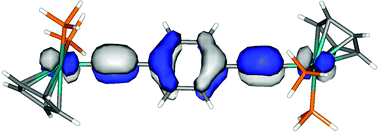Some transition metal complexes derived from mono- and di-ethynyl perfluorobenzenes†
Abstract
Transition metal alkynyl complexes containing perfluoroaryl groups have been prepared directly from ![[triple bond, length as m-dash]](https://www.rsc.org/images/entities/char_e002.gif) CC6F5 and RuCl(dppe)Cp′ [Cp′ = Cp, Cp*] in the presence of KF in
CC6F5 and RuCl(dppe)Cp′ [Cp′ = Cp, Cp*] in the presence of KF in ![[triple bond, length as m-dash]](https://www.rsc.org/images/entities/char_e002.gif) CC6F5)(dppe)Cp′ [Cp′ = Cp (2); Cp* (3)], which are related to the known compound Ru(C
CC6F5)(dppe)Cp′ [Cp′ = Cp (2); Cp* (3)], which are related to the known compound Ru(C![[triple bond, length as m-dash]](https://www.rsc.org/images/entities/char_e002.gif) CC6F5)(PPh3)2Cp (1). Treatment of Me3SiC
CC6F5)(PPh3)2Cp (1). Treatment of Me3SiC![[triple bond, length as m-dash]](https://www.rsc.org/images/entities/char_e002.gif) CC6F5 with Pt2(μ-dppm)2Cl2 in the presence of NaOMe in
CC6F5 with Pt2(μ-dppm)2Cl2 in the presence of NaOMe in ![[triple bond, length as m-dash]](https://www.rsc.org/images/entities/char_e002.gif) CC6F5)2 (4). The Pd(0)/Cu(I)-catalysed reactions between Au(C
CC6F5)2 (4). The Pd(0)/Cu(I)-catalysed reactions between Au(C![[triple bond, length as m-dash]](https://www.rsc.org/images/entities/char_e002.gif) CC6F5)(PPh3) and Mo(≡CBr)(CO)2Tp* [Tp* = hydridotris(3.5-dimethylpyrazoyl)borate], Co3(μ3-CBr)(μ-dppm)(CO)7 or IC
CC6F5)(PPh3) and Mo(≡CBr)(CO)2Tp* [Tp* = hydridotris(3.5-dimethylpyrazoyl)borate], Co3(μ3-CBr)(μ-dppm)(CO)7 or IC![[triple bond, length as m-dash]](https://www.rsc.org/images/entities/char_e002.gif) CFc [Fc = (η5-C5H4)FeCp] afford Mo(≡CC
CFc [Fc = (η5-C5H4)FeCp] afford Mo(≡CC![[triple bond, length as m-dash]](https://www.rsc.org/images/entities/char_e002.gif) CC6F5)(CO)2Tp* (5), Co3(μ3-CC
CC6F5)(CO)2Tp* (5), Co3(μ3-CC![[triple bond, length as m-dash]](https://www.rsc.org/images/entities/char_e002.gif) CC6F5)(μ-dppm)(CO)7 (6) and FcC
CC6F5)(μ-dppm)(CO)7 (6) and FcC![[triple bond, length as m-dash]](https://www.rsc.org/images/entities/char_e002.gif) CC
CC![[triple bond, length as m-dash]](https://www.rsc.org/images/entities/char_e002.gif) CC6F5 (7), respectively. The diruthenium complexes 1,4-{Cp′(PP)RuC
CC6F5 (7), respectively. The diruthenium complexes 1,4-{Cp′(PP)RuC![[triple bond, length as m-dash]](https://www.rsc.org/images/entities/char_e002.gif) C}2C6F4 [(PP)Cp′ = (PPh3)2Cp (8); (dppe)Cp (9); (dppe)Cp* (10)] are prepared from 1,4-(Me3SiC
C}2C6F4 [(PP)Cp′ = (PPh3)2Cp (8); (dppe)Cp (9); (dppe)Cp* (10)] are prepared from 1,4-(Me3SiC![[triple bond, length as m-dash]](https://www.rsc.org/images/entities/char_e002.gif) C)2C6F4 in a manner similar to that described for the monoruthenium complexes 1–3. The non-fluorinated complexes 1,4-{Cp′(PP)RuC
C)2C6F4 in a manner similar to that described for the monoruthenium complexes 1–3. The non-fluorinated complexes 1,4-{Cp′(PP)RuC![[triple bond, length as m-dash]](https://www.rsc.org/images/entities/char_e002.gif) C}2C6H4 [(PP)Cp′ = (PPh3)2Cp (11); (dppe)Cp (12); (dppe)Cp* (13)], prepared for comparison, are obtained from 1,4-(Me3SiC
C}2C6H4 [(PP)Cp′ = (PPh3)2Cp (11); (dppe)Cp (12); (dppe)Cp* (13)], prepared for comparison, are obtained from 1,4-(Me3SiC![[triple bond, length as m-dash]](https://www.rsc.org/images/entities/char_e002.gif) C)2C6H4. Spectro-electrochemical studies of the ruthenium
C)2C6H4. Spectro-electrochemical studies of the ruthenium


 Please wait while we load your content...
Please wait while we load your content...